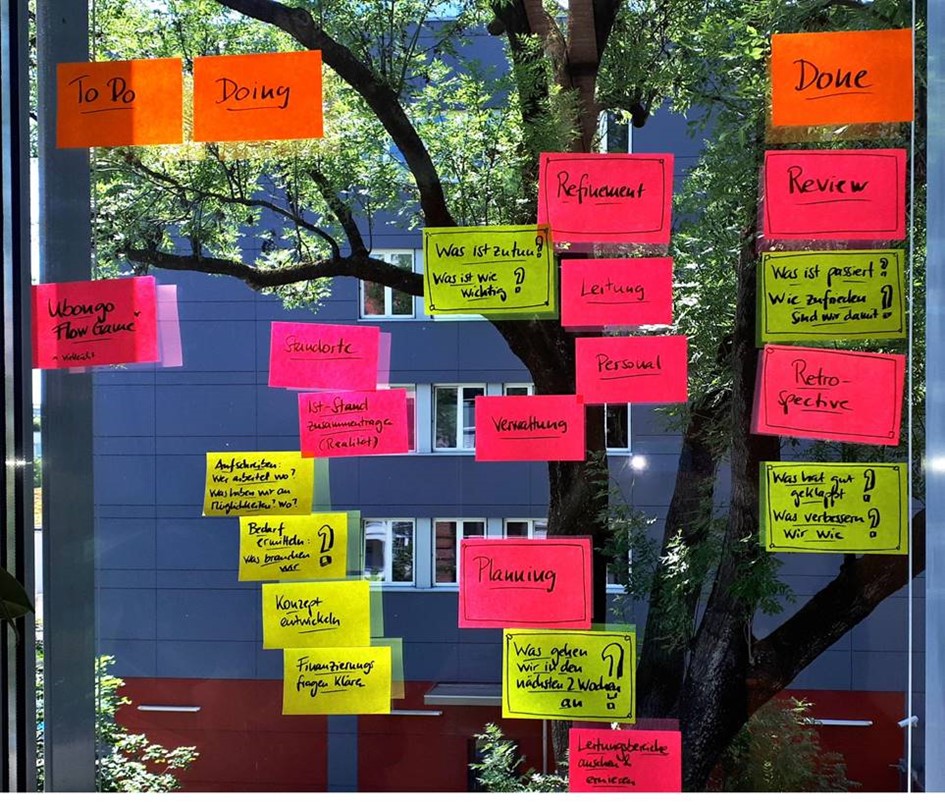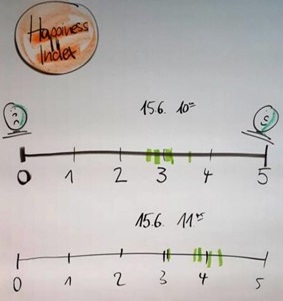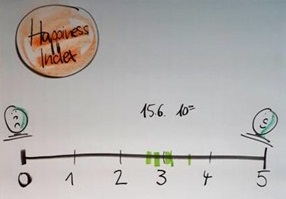There is no such thing as a sprint transition.
At least the Scrum Guide does not provide for them. For good reasons.Because it is better to deal with the Review, Retrospective and Refinement and Planning events in separate sessions*, i.e. on other days or at least in different sessions.
But we don’t always live in agile “Lala land” where everything is perfect. Teams then have to do it all the work in one session.
In such cases, the principle of “The Art of the Possible” applies. At least that’s what my mentors and colleagues Jan Fischbach and Marc Kaufmann (ScrumEvents) teach me. And also my experience.
Therefore,this little personal guidance on the sprint transition. It’s how I deal with it, especially when I work ” undercover” in an agile way, without making Scrum and agile working frameworks a big issue. When I go straight into action with the teams to solve problems.
The aim is always that the group facilitates their (e.g. fortnightly) sprint transitions themselves as soon as possible. Without my or any other external help.

Sprint transition guide
1. Appoint Moderator
- Instead of a fixed moderator, the team members could also take turns.
2. Happiness Index
- A scale from 1 to 5 is drawn on the flipchart. The meaning of the different levels:

1 = Unbearable. I want to get out of here.
2 = Bad, but there is hope.
3 = Just about bearable. There is still a lot to do.
4 = Running. If we can just…, then I’ll be completely satisfied.
5 = Everything is super good. Couldn’t be better.
- The meeting participants now enter (either openly or secretly, e.g. on the flipchart turned around) how happy they are at the moment (today! now!) with the situation in the team or in the process?
- The result is now shown to everyone. The subsequent (self-reflective) question: What do I/we need to move up a level? (Kaizen!!!).
- As a rule of thumb, I stick to the following: Everything to the right of the 3 is OK. The team is in relaxed improvement mode. If there is any indication oto the left of the three, this definitely is to be addressed and discussed with priority.
3. What have we worked on in the last two weeks? (Review)
- Have we achieved of what we set out to do (have we achieved our sprint goal)?
- Are we satisfied with that? What about our stakeholders?
- What needs to be reworked?
- Is it still so important that we have to take care of it immediately?
- If not, what is more important (look at the backlog)? Etc.
4. Backlog Views (Refinement): What are the to dos in general?.
- Discuss this together!
- What topics and tasks do we have to take care of as a whole (in the short, medium and long term)?
- Is something missing?
- Anything new, important has been added?
- What is important and how?
- What are the most important items in the backlog? They go to the top.
- Can they be finished in the next two weeks?
- If not, what are individual steps we can tackle so that we can at least start implementing them.
5. Plan Implementation (Sprint Planning): What Needs to be Done?
- The goal is to have 100% of the planned tasks completed by the end of the sprint!
- What are the issues and tasks we take on for the next two weeks?
- What is important enough to tackle it in the next two weeks?
- What concrete results do we want to achieve in the next meeting in a fortnight?
- What are realistic results?
- Do they really help us, our employees, customers or stakeholders?
- Is what we are planning to do really going to help us in our improvement process?
- Why?
Tip: It’s better to do less first, so better to tackle two or three smaller issues first!
6. Learning and Organising Together (Retrospective)
- In general, what worked well in the collaboration on the sprint goal?
- Short and concise manoeuvre critique, if possible PLEASE do it without a lot of general lamentation.
- Focus again and again on specific details to be improved.
- What did we do well? What not so much?
- What do we learn from this?
- Is it clear to all of us what we should or want to achieve on a higher level and why (vision)?
- What can we improve in general?
- What does this mean in concrete terms for implementation?
- Which one or two (smaller) improvement measures for the joint collaboration (not: each in his or her own area!) do we specifically plan for the next two weeks (Kaizen)?
Important: ALWAYS agree on at least one measure!
No retrospective without Kaizen!!!
7. Happiness Index

- As above.
- How am I doing NOW on a scale between 1 to 5?
8. Flashlight (Return on Time Invested)
- Short feedback, voluntarily: To what extent did the meeting benefit me and us?
- What was good?
- What do I wish for the next transition?
- What can we improve for holding this meeting in generally, what do I wish for the future in general or specifically for the co-operation?
Finally, a Few General Tips
- Make everything visible if possible!
- Use Post-Its, flipchart or other digital tools!
- Always! This will help you in your work and discussion.
- Because: Only what is visible can be managed!
- And it helps you document (photos instead of paperwork!)
What Else Comes To My Mind
- The Scrum Guide
- Jan Fischbach
- Marc Kaufmann
- ScrumEvents
- Rodehack, Edgar: Why the coloured notes (German)
* Strictly speaking, it is called: Sprint Planning, Sprint Review, Sprint Retrospective and Backlog Refinement. For the record.
